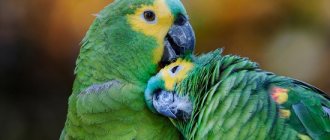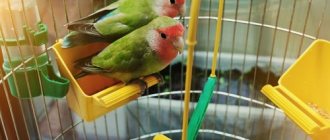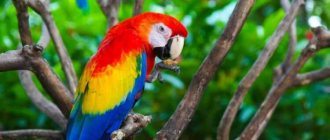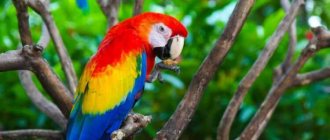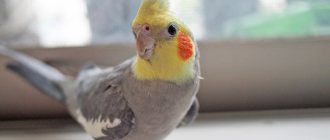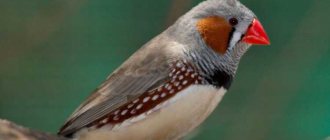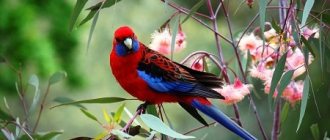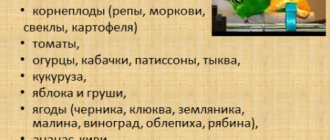There are a huge number of representatives of parrots. This order includes more than 330 species of very beautiful, bright, colorful birds. There are two families: cockatoos and parrots. The latter includes 5 subfamilies: true parrots, owl parrots, loris, woodpecker parrots, nestors. Parrots vary in size from species to species. Their body length ranges from 9.5 cm to 1 m. Bright colors predominate in the plumage. The beak is powerful and strong. With its help, the parrot not only obtains food, but also moves along the branches. Their diet includes mainly plant foods, nectar, pollen, and sometimes insects and larvae.
There are about 400 species of parrots in the world
A parrot is a large group of birds with curved beaks and often brightly colored plumage. There are about 400 known species of parrots, but, unfortunately, many of them are now in danger of complete extinction.
All parrots belong to the taxonomic order Psittaciformes. Researchers divide these birds into three main groups or superfamilies: true parrots, cockatoos and New Zealand parrots. They come in different shapes, sizes and colors. The plumage can be orange, green, blue, yellow, red, black, white and multi-colored. The size of the bird varies from 8 to 92 cm in length!
Photo: Tam Nguyen
Genus Ringed parrot
Himalayan ringed parrot
Plum-headed Ring-necked Parrot
Chinese ringed parrot
Rose-breasted Parakeet
Alexandrian ring-necked parrot
Indian ring-necked parrot
Parrots live mainly in the Southern Hemisphere
These birds live in a wide variety of habitats, but most are found in tropical or subtropical regions. In the Western Hemisphere, they are found from Mexico to Central and South America, as well as on nearby islands. They also inhabit sub-Saharan West Africa, India, Southeast Asia, Australia and the islands adjacent to the continent.
Different species have different ranges, and some populations overlap with populations of other species. Different species prefer different types of habitat: mixed, tropical and palm forests, savannas, meadows, desert margins. Some species live in city parks, gardens, farmland and highlands.
Lovebirds
In the African tropics and on the island of Madagascar live cheeky birds - lovebirds. Their name comes from a beautiful legend: a pair of parrots in love are so tightly bound by a romantic relationship that after the death of one of the partners, the other is deeply sad and no longer starts a family.
There are several known species of “inseparable” parrots:
- rosy-cheeked, he is most loved by breeders. It has green body plumage, a blue tail, and a pink mask on its head. New artificially bred colors are in high demand;
- masked - a very beautiful bird, whose characteristic feature appears in the form of white rings around the eyes and dark feathers on the front part;
- Fischer's lovebird, a bright and active bird with an orange head. Lives very well in captivity, quickly adapts to new conditions. This species has no speaking abilities;
- Liliana's lovebird, a very small and rarely seen species outside its natural range. The body color is dark green, the head is colored strawberry;
- black-winged, differs from other brothers in its large size - from beak to tail approximately 17 cm. The lower part of the wings is painted black. The male has a red forehead, the female's head plumage is completely green.
In nature, there are also black-cheeked lovebirds, gray-headed, collared and red-faced ones - they adapt extremely difficult to life in captivity, so they are rarely found in a tamed state. Among the bright and colorful species of parrots, lovebirds are one of the most interesting, distinctive and sociable birds.
Parrots are one of the most intellectually developed birds
Parrots learn well and quickly. They are able not only to learn words, but also to associate them with objects or circumstances. They are also able to imitate the sounds of other animals and copy various sounds of the environment. African gray parrots, Amazons and macaws imitate sounds best.
But parrots do not have vocal cords. They make sounds with their trachea as they push air out of it. Birds change the pitch of their sound by changing the shape and depth of their trachea. When parrots talk, they really just whistle.
Parrots can use assistive tools and solve puzzles. Some individuals were even taught to read, count, and collect objects by shape and color. Scientists say that parrots have an IQ equivalent to that of a four-year-old child. Parrots are very playful birds, and games are known to promote intellectual development.
Corella
A small cute bird is called a cockatiel in Australia, and a nymph in Europe. The natural gray color of the parrot perfectly camouflages it in natural conditions. The nymph is a common type of parrot for home breeding, along with budgerigars. A cockatiel can live next to people for 18–20 years if you surround it with care and communicate with friends every day. This talkative bird, when alone, can get sick and become depressed.
The size of the parrot is average: the length of the body including the tail is 33 – 35 cm. Breeders have developed several color variations:
- lutino;
- cinnamon;
- albino;
- motley;
- pearl and others.
A common feature of any mutation of the gray parrot breed is orange cheeks, as well as a funny forelock on the head, similar to the distinctive attribute of a cockatoo. The cute crest gives the friendly bird originality and charisma.
It cannot be said that the nymph has an outstanding talent for learning, but she can speak after hard practice. In addition, the crested bird loves to sing and imitate the sounds of the surrounding world: it imitates the barking of a dog, the noise of household appliances, and car alarms. Despite her pleasant appearance, the cockatiel is quite loud, her voice is harsh, you need to get used to it.
Parrots are the only birds that can feed with their paws
Parrots have zygodactyl feet, that is, they have four toes on each foot, two of which face backward and two forward. They have very powerful paws, allowing them to hold on to branches for a long time and even swing or hang upside down on them. However, that's not all they use their paws for.
Photo: David Clode
A parrot's feet are like human hands. They often use one paw to grasp food, branches and other objects, while using the other paw to balance their body. Parrots literally eat with their paws, bringing food to their mouths. It has even been observed that parrots prefer one paw over the other. Therefore, just like us humans, parrots can be left-handed or right-handed.
Parrots for children and beginners
Birds are kept for children. The birds are unpretentious in care and maintenance, the child learns responsibility. The future pet is chosen based on financial capabilities, living space and the age of the child. Errors are possible. At the persistent requests of a child, sometimes a large parrot is purchased. It ends badly: the bird returns to the pet store or to the breeder. This is the best case scenario. At worst, she is rarely remembered and kept in disgusting conditions. The pet dies due to poor care.
To avoid such a situation, it is advisable to familiarize yourself with the breed of bird you plan to purchase.
Who to choose for a small apartment, a cockatiel or a budgie? The child insists on cockatiel. This bird requires a large cage and quite expensive food. Will adults be able to support it? Is there a secluded corner for a cage in the apartment? Will the cockatiel be comfortable there? By answering these questions, parents will be able to make a final decision.
Important! A budgerigar would be an ideal pet for children. He is small, cheerful, and learns to talk easily. With good care, it can live up to 15 years.
Which parrot is better to have at home if the space allows you to keep a large bird, but there is no experience in keeping it? There is only one recommendation - a budgerigar. A novice “poultry farmer” can take care of him.
Budgerigars
Which parrot is best for a child, other than a budgie? The bird is good for its unpretentiousness and cheerful disposition. Budgerigars quickly become tamed and make contact easily. Able to remember and reproduce 150-200 words. With regular training, they will delight the little owner with their achievements.
The parents decided to get a parrot for their child. How to choose a budgie?
- The male, up to 6 months old, has a pink-violet beak. With age it turns blue. The older the bird, the brighter the blue color of the beak;
- In young females, the color of the beak is soft pink. In individuals older than six months, it becomes darker. An adult or old bird has a brown beak;
- There are black waves on the heads of young birds. After 4 months they disappear or become almost invisible;
- The parrot's cloaca area should be clean. If the bird's feathers and cloaca are contaminated with droppings, the parrot is not healthy;
- A healthy bird is active. She chirps cheerfully and pesters her cage neighbors. A ruffled parrot with dull or closed eyes is sick.
- If you plan to further train your parrot to talk, the male is ideal for this. Females chat less often.
- The cost of a bird ranges from 800 to 1500 thousand rubles. Males are more expensive than females.
cockatiels
The choice of a parrot for a home is based on the desire of the future owners and the ability to keep this or that bird. If you want to buy a large parrot, but there is too little space in your apartment, the cockatiel will be an alternative.
The parrot is classified as medium. It is slightly smaller in size than a pigeon. Cockatiels are mostly gray in color. But light yellow and ivory-colored individuals can be found. The birds have a funny crest on their heads. Males differ from females in their red “blush” on their cheeks and their massiveness. Female cockatiels are rather small, they have pale cheeks and a shorter crest. A Corella will cost about 3500-4000 thousand rubles.
Lovebirds
How to choose lovebirds? There are several subspecies: pink-cheeked, masked, Fisher's, black-cheeked, black-headed, collared. The list can be endless. The most common are rosy-cheeked, masked and Fischer. They differ in appearance.
The highlight of pink-cheeked birds is the color of their heads. The main background is most often green. The head is green-white. The cheeks are pale pink.
The masked lovebird is the most beautiful. The upper part of the head, back and chest are bright yellow. The muzzle is black, with a clearly visible red beak. Large white eyes with black pupils complete the image of the bird. The lower back and body are green.
Fisher's lovebird can be green or yellow. Its muzzle is painted bright orange or red. The beak is yellow or red. Of all the subspecies, this is the most expensive.
Males and females cannot be distinguished by appearance. It is acceptable to keep one parrot, but it will be sad and lonely. He has been wary of his owners all his life. He sits on your hand if you really try and train him, flies around the room, and responds to his name. However, he doesn’t like unnecessary touches. A solitary lovebird is more comfortable in a cage than with a person.
A couple of lovebirds are quite noisy at home. Birds are busy only with themselves, “talking” in their own language. They scream loudly, and the scream is quite disgusting. Having a child is not an option. Suitable for an adult or a married couple without children. Not everyone can withstand constant screaming. A pair of lovebirds can cost up to 10,000 - 12,000 thousand rubles.
Most parrots are herbivores
Each species has a different diet, but most in their natural habitat feed on a variety of plant foods, fruits, seeds, grains, leaves, berries, nuts, buds, nectar and pollen. Some species also eat insects, invertebrates and small animals. However, most species specialize in one type of food.
Many plants, as a result of evolution, have acquired chemical and mechanical defenses against herbivores. However, parrots have become virtually immune to the protection of such plants. For example, to detoxify toxic chemicals in seeds/fruits, some species of South American parrots (Conures, Amazons and Macaws) regularly eat clay from river banks. Alternatively, they eat small amounts of toxic seeds and combine them with large amounts of harmless seeds, greatly reducing the potential harm.
Population and species status
Parrots, as representatives of the species, have existed since the fifth century BC. For several millennia, the bird was exterminated because of its bright and beautiful plumage, and was caught for keeping in captivity. Active deforestation has also contributed to the decline in the number of such birds. Some species have already disappeared completely or are on the verge of extinction. Currently, the following are listed in the Red Book (IRC):
- Australian native parrot;
- Seychelles island parrot;
- some subspecies of Amazon parrots;
- grass common parrot;
- kakapo (night or owl parrot).
Kakapo is considered to be extinct in its natural habitat, so representatives of the species are kept today only in private nurseries and reserves. In addition to those listed, rare species include the Inca cockatoo, blue macaw, golden aratinga, royal amazon, as well as the Cuban macaw and Solomon cockatoo.
The conservation of rare species is carried out at the state and international level. For this purpose, the number of wildlife sanctuaries and reserves is increasing, and birds are being bred in captivity with the subsequent release of birds into their natural habitat. The fight against poaching and the ban on the illegal export of rare birds from the country are also considered effective.
Return to content
Some parrots can live over 80 years
The lifespan of a parrot varies depending on the species. Some of them may outlive their owners. While small parrots live a maximum of 20 years, medium-sized individuals live up to 30 years, and large ones can live up to a century.
The macaw is a long-lived parrot. One blue-and-yellow macaw named Charlie has passed the century mark. Another macaw named Poncho, who starred in several Hollywood films, has died at the age of 89. It is noteworthy that the age of a macaw can be determined by its eyes. Young birds have black eyes, while old macaws have yellow eyes.
The record for the oldest living parrot in captivity belongs to Cookie, Major Mitchell's cockatoo, who was 82 years old when he passed away in 2021. The maximum lifespan of a cockatoo under the most ideal conditions does not exceed 60-80 years.
Luxurious barraband parrot
It is also called barrabantine by another name. He lives in the eucalyptus forests of South-Eastern Australia. The body reaches 40 centimeters in length. The color of the main plumage is bright green, the throat and forehead are yellow.
In Europe and America it is often found at home. Speech abilities are below average. With proper organization of classes, he can learn to pronounce a few words, copy the sounds of other birds and domestic animals, and simple melodies.
Parrots have strong beaks
Photo: David Clode
One of the main features of the parrot is its wide, curved beak, with the lower beak often smaller than the upper. Parrot beaks are not only large and strong, but also tough. The largest flying parrot in the world, the hyacinth macaw's beak is strong enough to crack macadamia nuts, which are considered the most difficult to crack, as well as Brazil nut pods. He can even crack a coconut. For this reason, parrots should be handled with care.
What does a budgie eat?
Photo: Blue budgerigar
Wavy varieties are very successful developers of food and water resources. They feed on the ground and therefore prefer to collect grass and crop seeds, particularly spinifex and tuft grasses. In addition, their diet includes young shoots, fruits and berries. In nature, parrots eat grains of varying degrees of maturity, and they especially like young milk seeds.
Interesting fact: This species destroys growing grain crops and lawn grass seeds. Their ability to consume large quantities of seeds in swarms affects the interests of farmers.
They first clean the seeds and then swallow it whole or try to break it apart. The seeds are extremely rich in energy and are equivalent to the caloric content of animal tissue. Therefore, birds do not require an alternative food source. Budgerigars are very frequent water drinkers, drinking about 5.5% of their body weight per day. To meet this demand, they are often located near water sources.
Their activity, like that of most birds, begins shortly before sunrise with cleaning, singing and moving around within the trees. After sunrise, the birds fly to the feeding area and feed there throughout the day. They do not forage during midday or in very hot weather, instead they take refuge in the shade and remain motionless. At the end of the day, budgies gather, calling loudly and flying at high speeds around the trees. They then return to their roosting site just after sunset and remain alone until the next morning.
Many parrots mate for life
To attract a female, the male parrot displays himself, dances, makes various sounds and shows other signs of courtship. Once the female chooses him, they remain together for the rest of their lives, even outside the mating period. Monogamous couples help each other find food, care for each other, sleep together, and groom each other to strengthen their bond. Lovebirds are especially known for their strong bond, as they spend long hours just sitting together on the roost.
Reproduction
Thanks to the warm climate, budgies can breed all year round. Usually they choose a period when there is no drought and nature blooms. They prefer to nest in tree hollows or in secluded places on wide branches. The female does not need bedding; she lays her eggs on a bare surface. They incubate for 17-21 days, with 4-10 chicks per brood.
Babies are born blind and unfeathered, and gain sight in 10-12 days. It takes up to 50 days for the offspring to fully adapt, after which the chicks leave the parental nest and live independently. During the entire period of incubation and rearing, the male takes care of his family. Carries food and water, helps the female raise the young.
When the nest is empty, the parents are ready to immediately have new offspring. If the time is dry or cold weather is expected, the parrots leave their nests and fly away in search of a new site.
In males, the feathers on the forehead when exposed to ultraviolet rays begin to fluoresce (in simple terms, glow). This property helps them more easily attract a female during the mating season.
Parrots are caring parents
Photo: Roi Dimor
Most parrots do not build nests, but rather lay their eggs in rock cavities, tree holes, cacti, or human-built structures. However, monk parakeets (Quakers) build their own nests and connect them together to form structures similar to "bird condominiums" with separate rooms and nest entrances. These nesting structures can be the size of a small car and weigh more than 200 pounds.
During the mating season, females lay from 2 to 8 eggs, which are always white. The parents take turns sitting on the eggs. After 17-35 days, the eggs hatch into babies. They are cared for by both parents until they are ready to leave the nest.
Parrot chicks are blind for the first two weeks of their lives. After three weeks, their adult feathers begin to grow. Some species do not fledge until four months old and remain dependent on their parents for several years even after they can fly.
Kalita or monk parrot
The bird got its name due to the similarity of its color to the cassock of Capuchin monks. Its plumage is green, and its breast has a special, pale greenish-gray color, with green stripes crossing it. It lives in the countries of South America - Uruguay, Argentina, Paraguay, Bolivia. Its weight reaches 100 grams, and its height is 30 cm.
Kalitas are very active, sociable and inquisitive. They get along well with people when kept at home. They learn to speak relatively well. Their vocabulary reaches 100-200 words. But these parrots scream very often and loudly, which can cause serious inconvenience.
Parrots have been kept as pets for 3,000 years
Parrots were first kept as pets by the ancient Egyptians, and later by the American Indians and Chinese. They were brought to Europe in the 3rd century BC. and were often kept in the homes of rich people or nobles. Such famous figures as Aristotle, Marco Polo, the monarch Henry VIII, Queen Isabella, Marie Antoinette, Victoria, the Washington couple, Teddy Roosevelt and Steven Spielberg had pet parrots.
Today, parrots remain the most popular pet birds in the world. However, keep in mind that if you are planning on getting your own pet bird, it will need plenty of space to exercise and explore. If left untrained, he will become excessively noisy and bite. Parrots' enclosures should be very large and include a variety of toys and materials for them to chew and tear. In addition to mental stimulation in the form of various toys and puzzles, these birds also need constant interaction and affection.
Congo parakeet
These African parrots are found in the western and central parts of the continent. Their physical characteristics are as follows:
- Body length up to 29 centimeters.
- The main color is green.
They are divided into three types - large, small and black-winged.
Can be successfully kept in captivity. They copy the sounds of other birds and animals and musical melodies well. The ability to reproduce the human voice is usually poorly developed. But some birds, after persistent and regular training, had a vocabulary comparable to gray parrots. This is especially true for individuals born in captivity.
Cockatoos can move their head feathers
Photo: Terra Roro
Cockatoos are Old World parrots that are usually not as brightly colored as other parrot species. Their feathers lack the chemicals responsible for blue and green colors, so they have duller colors. Their most distinctive feature is the feathers on their heads, which they can move in the same way dogs can move their ears. The feathers on a cockatoo's head often rise when flying or landing, when scared, angry or excited. In other cases, they fit tightly to the bird’s head, giving the impression that they are not there at all.
Parrot and man
Parrots have been kept in captivity since ancient times; this custom became widespread in India. At first they were only in the palaces of the maharajas, but over time they appeared in the houses of people from the noble caste. Having such a bird in the house was considered a great luxury, so only very rich people could afford it. Special cages were made for them and a servant was assigned to feed and care for the parrot. It was probably one of these servants who began to talk to the parrots, and in response he heard the first word uttered by the bird. Well, be that as it may, teaching a parrot human speech has become a tradition among the Hindus; it is believed that every noble person should have a talking bird. Such people can still be found today. Dr. Sri Ganapati Sachhidananda Swamiji dedicated his life to birds. He built an aviary with an area of 8.4 hectares, which is now home to 468 species of birds. There are especially many parrots, which he provided not only with housing and food, but also looked after their health.
Today, a parrot is a common thing in an Indian home; they are kept in almost every family and many even breed these birds. They are given the same special treatment, they are groomed, cherished, taught to speak and allowed to do whatever they want, they have the right to be the favorites of all household members.
Parrots came to Europe a very long time ago. According to historians, the first such tamed birds were brought to Greece by the commander of Alexander the Great, Onesicritus. These unusual birds quickly became popular in Greece and then in Ancient Rome. The Romans highly valued the talking bird, but it was only available to high-born patricians, because the price of a talking parrot was even higher than the cost of a slave. Expensive cages were made of silver and ivory for them, and a special teacher was assigned to teach them human speech.
Parrots received a special position among Catholics. He was declared a divine bird for his speaking abilities. Back in the Middle Ages, at the residence of the Pope, in the Lateran, a large number of parrots were kept and a special caretaker was assigned to them. These birds were called "papagall", which means "papal rooster", from which the modern name "parrot" comes. And today a large number of them live in the Vatican, and they live there freely. Monk parrots, originally from South America, no one knows how they appeared here, settled an entire colony in the papal garden. And behind the Vatican train station, parrots who escaped from the homes of the inhabitants of Rome found shelter. Dad himself also sometimes communicates with these birds.
Parrots were brought from America to Europe by the Spaniards and Portuguese after Christopher Columbus's voyage there. Due to their striking appearance, these birds quickly became fashionable, and thousands of them began to be imported. And although quite a few of them died in the holds of ships during the journey, they were transported and sold for substantial money. After the settlement of Australia, starting in 1840, enterprising Europeans began to supply new species of parrots, including budgerigars. So many of them were exported that the Australian government banned their catching in 1894 in order to preserve the population. But by this time, European ornithologists were able to organize the breeding of these birds in captivity. Moreover, the wavy ones brought from Australia were all green, and breeders ensured that multi-colored parrots appeared, which became the most popular indoor birds.
Parrots appeared in Russia much later. These exotic birds were first mentioned by Ivan Zabelin in his work “The Home Life of Russian Tsars in the 16th and 17th Centuries,” where it is said that in 1597 Emperor Rudolf sent six parrots as a gift to Tsar Boris Fedorovich Godunov. Following the example of the tsar, boyars, and then merchants, began to start them. Only very rich people could afford to keep these exotic birds in their homes.
Parrots became popular as birds kept at home at the beginning of the twentieth century. The owners and breeders of these birds began to communicate with each other, share experiences, form societies, organize exhibitions, demonstrating new species obtained as a result of selection. This especially affected budgerigars, the species of which have become so numerous that they cannot even be counted.
The largest parrot in the world cannot fly
The kakapo is the largest parrot in the world. It can weigh up to 4.6 kg and be over 60 cm long. By comparison, the smallest parrot in the world, the tawny-faced pygmy parrot, weighs only 10 grams and grows to a maximum of 7.6 cm.
The kakapo is actually the only flightless parrot on the planet. It is also the only parrot that is active at night, a feature that helps it evade predators. Although the kakapo cannot fly, it can jump and deftly climb trees in search of fruits. Unfortunately, the kakapo is now one of the rarest birds in the world. There are less than 150 individuals left in the wild.
It is also noteworthy that the vast majority of parrots look the same, regardless of gender, but the male kakapo is larger than the female, with a shorter tail and shorter beak.
Popular questions
What are the main differences between parrots and other birds?
The parrot cannot be confused with anyone. Look at its massive, down-curved, strong beak. And parrots use it very skillfully. Their beak serves as a device for capturing and grinding food, for climbing trees (just like a third leg), and can also be a formidable weapon. In addition, the parrot has short but developed legs. They help the bird to hold onto the fruits it has caught, and they are also used by the parrot to bring food to its beak.
How many species of parrots are there and where do they live?
There are more than 330 species in the Psittacidae family, and another 20 are part of the cockatoo family, which are also members of the Psittacidae order. All these birds are very thermophilic, which is why they live in subtropical and tropical climates. The most numerous colonies of parrots are in Australia. They are also widespread in the forests of Southeast Asia, West Africa, South and Central America. And a huge number of parrots live in our houses and apartments, because this bird is easily tamed.
What parrots talk?
Parrots differ from other birds not only in the rich colors of their plumage, but also in their ability to “talk.” Of course, parrots do not speak, but only imitate human speech, but this is a very great achievement for a living creature: after all, no one except parrots in the animal world has such an ability. Scientists involved in research into the life and characteristics of parrots claim that the whole point is in the special structure of the speech organs, in particular the language, thanks to which parrots copy human words, perceiving them as the sounds of their “relatives”.
As it turned out, almost all parrots can “speak” and not all of them can accurately reproduce the voice and words of a person. The ability to repeat words after people manifests itself differently in different species of parrots. The best imitators of humans are gray and Amazon parrots, cockatoos and macaws . And gray Jaco parrots copy not only the sounds of human speech, but also the intonation and even the features of the voice. All these birds are usually grouped together under the name " talking parrots ".
What is the most popular pet parrot?
One of the most popular pets in our country is the budgerigar. It got its name from the wavy stripes on its plumage. This small bird loves to make noise and is talkative. Budgerigars remember words and entire expressions quite easily. In the wild, these birds live in Australia, where they roam from place to place in huge flocks in search of food and water.
What is the largest parrot in the world?
In the South American jungle there lives a large parrot with blue-cobalt plumage - it is impossible not to recognize it. This is a hyacinth macaw. The body length of this giant can reach 1 meter, and its weight can reach 1.5 kilograms! The bird has a massive black beak, and at the base of the mandible there is a wide golden stripe. The loud and sharp guttural voice of this parrot can be heard at a distance of more than a kilometer from the bird’s location.
What is the life expectancy of parrots?
Contrary to the common misconception that the lifespan of parrots can reach 100 years or more, this is by no means true: it is rare for their age to exceed 50 years. Although there is information about parrots 65–70 years old.
According to the Green Parrot Bird Hospital, the life expectancy of budgerigars in captivity is 12-13 years, with 1 in 100 budgerigars living to be 16 years old, and 1 in several thousand budgerigars living to be 18-19 years old. Also, in the bird hospital, the life expectancy of Cuban Amazons in captivity was determined precisely - they reach old age at 35 years, and they practically do not overcome the 40-year life threshold.
Which member of the parrot family lives the longest?
This is a gray parrot, or gray parrot.
Its average lifespan is approximately 60 years. However, some individuals live up to 90! The gray's body length is 30 centimeters. It has a black curved beak and gray feathers. Jaco has a high intelligence and excellent ability to imitate.
Kea is the only alpine parrot
Photo: Pavlina Trauskeova/ Shutterstock
Kea, the kakapo's cousin, is also unique. While most parrots live in warm places, kea live in cold, high-altitude environments. It has thick feathers that provide warmth in chilly weather and a round body that allows it to retain heat. Keas are known to be very intelligent and curious birds. However, sometimes their curiosity causes serious harm. Kea sometimes peck at cars, brightly colored backpacks and human clothing. Cases of theft of wallets, passports and jewelry have also been reported. Mischievous, isn't it?
Breeding history
After John Gould brought a budgerigar to England in 1840, the strange bird began to be delivered by sea to Germany, Belgium and France. The cost was high, so European breeders immediately began trying to breed offspring in an artificial environment.
The first brood was obtained by the French poultry farmer Solby in 1854. His compatriot, Jules Delon, published an article in which he described the rules for keeping and caring for a budgie. In 1855, Germany reported its successful experiments in breeding chicks in captivity. The offspring appeared in the house of Countess von Schweren. In Belgium, scientists at the Antwerp Zoo were breeding parrots.
Large companies from leading countries responded to the demand, and by 1860 all famous zoos had already started breeding exotic birds. In 1880, 25 thousand chicks were bred in Germany alone. In Russia, scientists studied budgies in 1930. They were first raised at the Moscow Zoo.
Thanks to the work of world breeders, by the middle of the 20th century there were more than 200 species of domestic budgerigars.
Did you know?
- About 130 species of parrots are threatened with extinction. Unfortunately, the parrot trade is one of the main reasons why many species are now rarely seen in the wild.
- Fossils of modern parrots with the same bone structure and appearance have been found dating back 23 million years.
- In many species of parrots, males and females are identical in appearance, and a blood test is required to determine the sex.
- The parrot's beak is constantly growing, so it is forced to wear it down by gnawing wood and rubbing the upper and lower parts of the beak against each other.
- They are able to see ultraviolet light, invisible to humans.
- Wild macaws and cockatoos can fly up to 800 km a day in search of food.
- Chocolate is a poisonous treat for parrots.
- Most parrots sleep standing on one leg.
- The most talented talking bird is a budgerigar named Puck. His vocabulary totaled more than 1,700 words!
Cockatoo
It is known that the name of this species of parrot is associated with its powerful beak - in Malay “kakatua” means “biters”. The structure of the beak allows it to crack the hardest nuts, chew through thick branches, bite through cage bars, and even open locks. Another noticeable feature of the bird is the high crest of pink or yellow feathers on the crown. The cockatoo is considered a large species: its body with tail reaches a length of 70 cm. The wingspan of the average individual is 80 cm. They live in captivity for more than 40 years under favorable circumstances.
The family is divided into several species: yellow-crested, Inca, Moluccan, pink, black and others. The most luxurious breed is the Solomon white parrot. He has a spectacular appearance with a predominance of snow-white feathers, and a large crest of the same shade on his head.
Cockatoos are perfectly adapted to wild living conditions: they fly well, deftly climb trees and move quickly on the ground. The domestic parrot has nowhere to use these skills, so he has fun in any available way:
- with the help of a curved beak, he breaks open the locking mechanism of the door, pushes back the bolt and gets out of the cage;
- chases small domestic animals, treats them unceremoniously and mimics them;
- destroys furniture, chews wires, tears books and flowers;
- dances to the music and makes others laugh, enjoying their reactions.
The cockatoo is vindictive and aggressive, and can bite hard if it feels threatened. To channel the parrot’s unbridled energy into a peaceful direction, you need to transfer its attention to various puzzles and overcoming obstacles. Training and learning onomatopoeia is very interesting for cockatoos, as these birds are very intelligent and resourceful.
